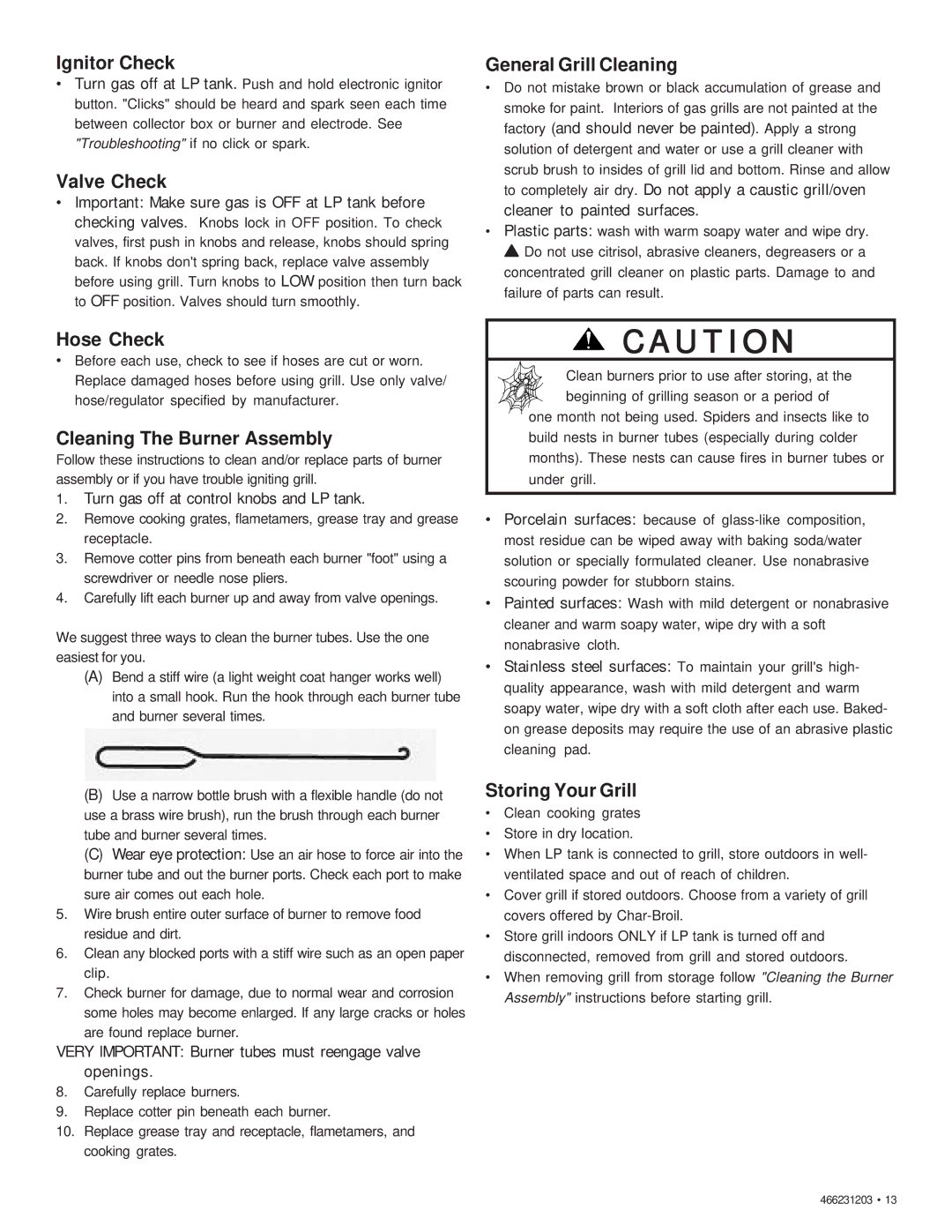
Ignitor Check
•Turn gas off at LP tank. Push and hold electronic ignitor button. "Clicks" should be heard and spark seen each time between collector box or burner and electrode. See "Troubleshooting" if no click or spark.
Valve Check
•Important: Make sure gas is OFF at LP tank before checking valves. Knobs lock in OFF position. To check valves, first push in knobs and release, knobs should spring back. If knobs don't spring back, replace valve assembly before using grill. Turn knobs to LOW position then turn back to OFF position. Valves should turn smoothly.
Hose Check
•Before each use, check to see if hoses are cut or worn. Replace damaged hoses before using grill. Use only valve/ hose/regulator specified by manufacturer.
Cleaning The Burner Assembly
Follow these instructions to clean and/or replace parts of burner assembly or if you have trouble igniting grill.
1.Turn gas off at control knobs and LP tank.
2.Remove cooking grates, flametamers, grease tray and grease receptacle.
3.Remove cotter pins from beneath each burner "foot" using a screwdriver or needle nose pliers.
4.Carefully lift each burner up and away from valve openings.
We suggest three ways to clean the burner tubes. Use the one easiest for you.
(A)Bend a stiff wire (a light weight coat hanger works well) into a small hook. Run the hook through each burner tube and burner several times.
(B)Use a narrow bottle brush with a flexible handle (do not use a brass wire brush), run the brush through each burner tube and burner several times.
(C)Wear eye protection: Use an air hose to force air into the burner tube and out the burner ports. Check each port to make sure air comes out each hole.
5.Wire brush entire outer surface of burner to remove food residue and dirt.
6.Clean any blocked ports with a stiff wire such as an open paper clip.
7.Check burner for damage, due to normal wear and corrosion some holes may become enlarged. If any large cracks or holes are found replace burner.
VERY IMPORTANT: Burner tubes must reengage valve openings.
8.Carefully replace burners.
9.Replace cotter pin beneath each burner.
10.Replace grease tray and receptacle, flametamers, and cooking grates.
General Grill Cleaning
•Do not mistake brown or black accumulation of grease and smoke for paint. Interiors of gas grills are not painted at the factory (and should never be painted). Apply a strong solution of detergent and water or use a grill cleaner with scrub brush to insides of grill lid and bottom. Rinse and allow to completely air dry. Do not apply a caustic grill/oven cleaner to painted surfaces.
•Plastic parts: wash with warm soapy water and wipe dry. ▲ Do not use citrisol, abrasive cleaners, degreasers or a concentrated grill cleaner on plastic parts. Damage to and failure of parts can result.
![]() CAUTION
CAUTION
Clean burners prior to use after storing, at the beginning of grilling season or a period of
one month not being used. Spiders and insects like to build nests in burner tubes (especially during colder months). These nests can cause fires in burner tubes or under grill.
•Porcelain surfaces: because of
•Painted surfaces: Wash with mild detergent or nonabrasive cleaner and warm soapy water, wipe dry with a soft nonabrasive cloth.
•Stainless steel surfaces: To maintain your grill's high- quality appearance, wash with mild detergent and warm soapy water, wipe dry with a soft cloth after each use. Baked- on grease deposits may require the use of an abrasive plastic cleaning pad.
Storing Your Grill
•Clean cooking grates
•Store in dry location.
•When LP tank is connected to grill, store outdoors in well- ventilated space and out of reach of children.
•Cover grill if stored outdoors. Choose from a variety of grill covers offered by
•Store grill indoors ONLY if LP tank is turned off and disconnected, removed from grill and stored outdoors.
•When removing grill from storage follow "Cleaning the Burner Assembly" instructions before starting grill.
466231203 • 13
